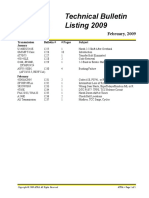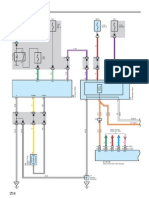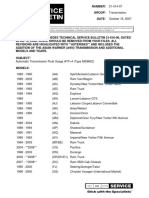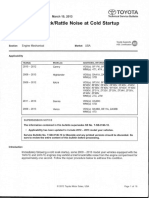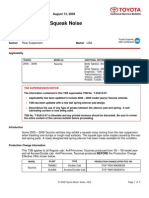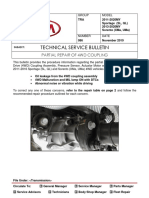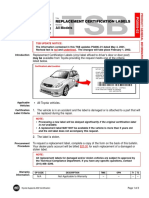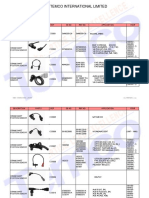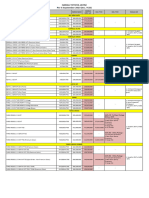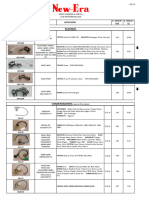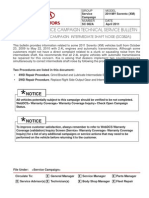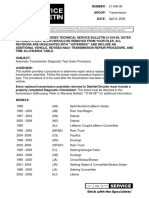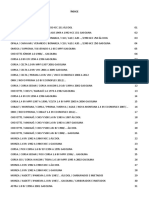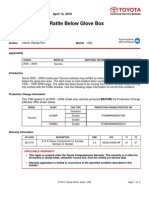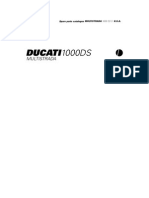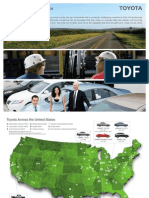T SB 0141 10
T SB 0141 10
Uploaded by
goombaCopyright:
Available Formats
T SB 0141 10
T SB 0141 10
Uploaded by
goombaOriginal Title
Copyright
Available Formats
Share this document
Did you find this document useful?
Is this content inappropriate?
Copyright:
Available Formats
T SB 0141 10
T SB 0141 10
Uploaded by
goombaCopyright:
Available Formats
T-SB-0141-10 June 4, 2010
Upper/Lower Windshield/Rear Glass Tick Noise
Service
Category Vehicle Exterior
Section Window/Glass Market USA
Applicability
YEAR(S) MODEL(S) ADDITIONAL INFORMATION
2003 – 2011 4Runner, Avalon,
Camry, Camry HV,
Celica, Corolla, Echo,
FJ Cruiser, Highlander,
Highlander HV, Land
Cruiser, MR2 Spyder,
Matrix, Prius, RAV4,
Sequoia, Sienna,
Solara, Tacoma,
Tundra, Venza, Yaris
TSB SUPERSESSION NOTICE
The information contained in this TSB supersedes T-SB-0142-08.
• Applicability has been updated to include 2010 – 2011 model year applicable vehicles.
T-SB-0142-08 is Obsolete and any printed versions should be discarded. Be sure to review the
entire content of this service bulletin before proceeding.
Introduction
If a creak, tick, or rattle noise is heard at the top or bottom of the windshield, or at the top of the
rear glass, the source of the noise may be the two stoppers bonded to the top of the windshield/rear
glass, or the windshield retainers bonded to the lower edge of the windshield. This bulletin provides
the recommended repair procedure to eliminate these types of noises from the windshield/rear
glass area.
NOTE
Some vehicles have both stoppers and retainers while others may only have stoppers at the
top of the windshield/rear glass. Use the chart in this bulletin to determine the location of the
windshield/rear glass locating pins.
© 2010 Toyota Motor Sales, USA Page 1 of 9
T-SB-0141-10 June 4, 2010 Page 2 of 9
Upper/Lower Windshield/Rear Glass Tick Noise
Warranty Information
OP CODE DESCRIPTION TIME OFP T1 T2
NV5019 Remove Top Windshield Locating Stoppers (2) 0.4
Remove Top Rear Glass Locating Stoppers
Combo A (2) (only for 09 Corolla if noise from both 0.4
windshield and rear glass) 5611#–#####
Remove Bottom Windshield Locating
Combo B Retainers (2) (only as needed for Avalon, 0.3 91 41
Camry, and Solara)
Remove Bottom Windshield Locating
NV5020 0.3 56114–#####
Retainers (2)
Remove Top Rear Glass Locating Stoppers (2)
NV8050 0.4 56116–#####
(only for 09 Corolla if noise from rear glass)
APPLICABLE WARRANTY
• This repair is covered under the Toyota Comprehensive Warranty. This warranty is in effect for
36 months or 36,000 miles, whichever occurs first, from the vehicle’s in-service date.
• Warranty application is limited to occurrence of the specified condition described in this
bulletin.
Required Tools & Equipment
SPECIAL SERVICE TOOLS (SST’S) PART NUMBER QTY
Plastic Pry Tool Set* 00002-06000-01 1
* Essential SST.
NOTE
Additional SSTs may be ordered by calling 1-800-933-8335.
© 2010 Toyota Motor Sales, USA
T-SB-0141-10 June 4, 2010 Page 3 of 9
Upper/Lower Windshield/Rear Glass Tick Noise
Retainer/Stopper Locations
STOPPERS AT THE TOP OF RETAINERS AT THE BOTTOM
MODEL QTY QTY
THE WINDSHIELD OF THE WINDSHIELD
4Runner N/A N/A
Avalon
Yes 2
Camry (All Models)
Celica
Corolla
ECHO
FJ Cruiser
Highlander (All Models)
Land Cruiser
Matrix N/A N/A
Yes 2
MR2 Spyder
Prius
RAV4 (All Models)
Sequoia
Sienna
Solara Yes 2
Tacoma
N/A N/A
Tundra
Venza Yes 2
Yaris N/A N/A
STOPPERS AT THE TOP OF
MODEL QTY BOTTOM OF REAR GLASS QTY
THE REAR GLASS
2009 Corolla only Yes 2 N/A N/A
© 2010 Toyota Motor Sales, USA
T-SB-0141-10 June 4, 2010 Page 4 of 9
Upper/Lower Windshield/Rear Glass Tick Noise
Retainer/Stopper Locations (Continued)
Figure 1. Retainer and Stopper Locations
1 Stopper
2 Retainer
Figure 2. Retainers Figure 3. Stoppers
© 2010 Toyota Motor Sales, USA
T-SB-0141-10 June 4, 2010 Page 5 of 9
Upper/Lower Windshield/Rear Glass Tick Noise
Repair Procedure
Windshield Glass Stoppers (at Top of Windshield)
1. Remove both sun visors and both A-pillar Figure 4. .
garnishes, and then carefully lower the front of
the headliner to gain access to the windshield
stoppers (refer to the appropriate model year
Repair Manual for the proper procedure for
removing and reinstalling the sun visors and
headliner).
NOTICE
It is very important that the front of the
headliner be lowered carefully and slowly.
Applying too much downward force on the
headliner will cause it to develop a permanent
crease in the surface material.
1 20 – 25 cm (7.9 – 9.8 in.)
The stoppers are located on the inside of the 2 20 – 25 cm (7.9 – 9.8 in.)
passenger compartment behind the windshield
glass blackout section (near the top front edge
of the metal roof opening). The stoppers are
typically located 20 – 25 cm (7.9 – 9.8 in.) inboard
of the top corners of the windshield glass.
© 2010 Toyota Motor Sales, USA
T-SB-0141-10 June 4, 2010 Page 6 of 9
Upper/Lower Windshield/Rear Glass Tick Noise
Repair Procedure (Continued)
Windshield Glass Stoppers (at Top of Windshield) (Continued)
2. Cut OFF the tip of the plastic stopper as shown in Figure 5.
NOTE
Stopper design varies by vehicle model and may not appear exactly as shown below. Photos
of actual stoppers appear on page 4 of this bulletin (Figures 2 and 3).
Figure 5.
1 Windshield Glass 4 Cut
2 Roof Panel 5 Fragment of Glass Stopper
3 Glass Stopper
HINT
It is sometimes necessary to bend the metal body tab down to gain access to the shaft
of the stopper.
© 2010 Toyota Motor Sales, USA
T-SB-0141-10 June 4, 2010 Page 7 of 9
Upper/Lower Windshield/Rear Glass Tick Noise
Repair Procedure (Continued)
Windshield Glass Stoppers (at Top of Windshield) (Continued)
3. Once the tip of the stopper has been removed, use a screwdriver to open a gap between the
roof panel and the remainder of the plastic windshield stopper.
NOTE
Apply tape to the screwdriver tip before use to prevent scratching.
Figure 6.
1 Opening Gap 2 Roof Panel
4. Test drive vehicle prior to reassembly to confirm that the noise has been eliminated.
5. Reassemble the vehicle.
© 2010 Toyota Motor Sales, USA
T-SB-0141-10 June 4, 2010 Page 8 of 9
Upper/Lower Windshield/Rear Glass Tick Noise
Repair Procedure (Continued)
Windshield Retainers (at Lower Edge of Windshield)
1. Carefully remove the plastic cowl top ventilator louver at the base of the windshield and store
it in a safe location for reinstallation later (refer to the appropriate model year Repair Manual
for the proper procedure).
Figure 7.
1 Cowl Top Ventilator Louver
2. Locate the lower windshield retainers.
The retainers are typically located 140 – 200 mm (5.5 – 7.9 in.) inboard of the lower corners of
the windshield. The flat portion of the retainer is adhered to the backside of the windshield with
double-sided, foam-backed tape.
Figure 8.
1 Pin Is Attached to Plastic Block Underneath Windshield
© 2010 Toyota Motor Sales, USA
T-SB-0141-10 June 4, 2010 Page 9 of 9
Upper/Lower Windshield/Rear Glass Tick Noise
Repair Procedure (Continued)
Windshield Retainers (at Lower Edge of Windshield) (Continued)
3. Use a “mini” hacksaw with a fine tooth 10-inch Figure 9. View from Underneath Windshield.
blade to cut OFF the pin portion of the glass
retainer flush with the flat portion of the windshield
retainer as shown in Figure 9.
1 Pin
4. Test drive the vehicle to confirm the elimination of the noise.
5. Reinstall the cowl top ventilator louver.
Rear Glass Stoppers (at Top of Rear Glass)
For removal of rear glass stoppers, refer to step 1 of the Windshield Glass Stoppers section.
© 2010 Toyota Motor Sales, USA
You might also like
- MIL "ON" DTC P0705: T-SB-0277-09 August 18, 2009Document11 pagesMIL "ON" DTC P0705: T-SB-0277-09 August 18, 2009goomba100% (4)
- T CP ZTHDocument63 pagesT CP ZTHgoomba100% (3)
- GM 4L80E Transmissions: How to Rebuild & Modify: How to Rebuild & ModifyFrom EverandGM 4L80E Transmissions: How to Rebuild & Modify: How to Rebuild & ModifyRating: 5 out of 5 stars5/5 (1)
- UP-CRST01 Rev.A0.2 - 0 - 0: Index Index IndexDocument13 pagesUP-CRST01 Rev.A0.2 - 0 - 0: Index Index IndexMunawar AliNo ratings yet
- 02-2009 4t65e, F4a23-33, A246e Check Ball, Ax4s-Ax4n-4f50n Codes DTCDocument16 pages02-2009 4t65e, F4a23-33, A246e Check Ball, Ax4s-Ax4n-4f50n Codes DTCAle100% (1)
- Diagnostic Tester Immobilizer Functions T-SS003-02Document14 pagesDiagnostic Tester Immobilizer Functions T-SS003-02Daniel Torres100% (1)
- Denso Original CatalogueDocument16 pagesDenso Original CatalogueегорNo ratings yet
- Export Vehicle Application Guide July 2014Document180 pagesExport Vehicle Application Guide July 2014jairofgf50% (2)
- T SB 0119 10Document7 pagesT SB 0119 10goombaNo ratings yet
- 234-237 Accessory MeterDocument4 pages234-237 Accessory Metergoomba100% (3)
- Live in Grace, Walk in Love: A 365-Day JourneyDocument4 pagesLive in Grace, Walk in Love: A 365-Day JourneyNina ForeelNo ratings yet
- T SB 0142 08Document9 pagesT SB 0142 08goombaNo ratings yet
- Catalogo Lorenz 2019 PDFDocument84 pagesCatalogo Lorenz 2019 PDFAceitera Frank100% (2)
- Catálogo Filtros Lorenz PDFDocument242 pagesCatálogo Filtros Lorenz PDFAceitera Frank100% (3)
- Catalogo Reparo Bomba e Dir Hidr Seg LeveDocument6 pagesCatalogo Reparo Bomba e Dir Hidr Seg LeverafwebNo ratings yet
- Technical Service BULLETINDocument5 pagesTechnical Service BULLETINdanieldario33No ratings yet
- Number: Group: DateDocument4 pagesNumber: Group: Datejoker63000No ratings yet
- T SB 0149 10Document18 pagesT SB 0149 10goombaNo ratings yet
- Infiniti Service BulletinDocument6 pagesInfiniti Service BulletinAlfonsoNo ratings yet
- SB 10061557 2280Document16 pagesSB 10061557 2280johndere2090No ratings yet
- T SB 0274 09Document5 pagesT SB 0274 09goombaNo ratings yet
- Nisshinbo 2017Document262 pagesNisshinbo 2017alekNo ratings yet
- T SB 0385 09Document6 pagesT SB 0385 09goomba100% (1)
- PD017 04Document3 pagesPD017 04Christian Linares AbreuNo ratings yet
- Export Vehicle Application Guide October 2013Document175 pagesExport Vehicle Application Guide October 2013Francisco BeloucheNo ratings yet
- Guia Accesorios Arb Enero 2015 PDFDocument183 pagesGuia Accesorios Arb Enero 2015 PDFTony MarascaNo ratings yet
- 6-Speed Manual Clutch Release Bearing Squeak or Rattle NoiseDocument9 pages6-Speed Manual Clutch Release Bearing Squeak or Rattle NoiseinvisiblerNo ratings yet
- RotulasDocument3 pagesRotulasWUSHU JCKNo ratings yet
- MC 10168851 0001Document5 pagesMC 10168851 0001Dyego Henrique0% (1)
- P0440, P0441 OR P0446camry1 PDFDocument5 pagesP0440, P0441 OR P0446camry1 PDFВИКТОР СЕВЕРNo ratings yet
- CLICKING NOISE NissanDocument5 pagesCLICKING NOISE NissanBenNo ratings yet
- MC 10132100 9999Document16 pagesMC 10132100 9999marranNo ratings yet
- T SB 0075 09Document2 pagesT SB 0075 09goombaNo ratings yet
- LPGM 25Document2 pagesLPGM 25FelixAlbertoGarciaNo ratings yet
- Filtros Ac DelcoDocument12 pagesFiltros Ac DelcoJOSE OROZCONo ratings yet
- Ford Rep Matrix 7-5-06Document41 pagesFord Rep Matrix 7-5-06rodrigo michel100% (1)
- Technical Service Bulletin: 2011 Iqs Aged Inventory Handling GuidelinesDocument3 pagesTechnical Service Bulletin: 2011 Iqs Aged Inventory Handling GuidelinesTrọng Nghĩa VõNo ratings yet
- UntitledDocument1 pageUntitledzaida mariñaNo ratings yet
- Replacement Certification LabelsDocument2 pagesReplacement Certification LabelsTung NguyenNo ratings yet
- Auto Trans OverhaulDocument102 pagesAuto Trans OverhaulIngenieria MultifuncionalNo ratings yet
- Renault Kangoo (2000)Document191 pagesRenault Kangoo (2000)paceb40370100% (1)
- T-SB-0316-17 Vacuum Pump Knocking NoiseDocument3 pagesT-SB-0316-17 Vacuum Pump Knocking NoiseRhytham SoniNo ratings yet
- Kia Sorento XM TSB042 PDFDocument2 pagesKia Sorento XM TSB042 PDFAlfateh KingNo ratings yet
- L SB 0090 08 PDFDocument10 pagesL SB 0090 08 PDFbob loblawNo ratings yet
- Cam Bien Truc CoDocument42 pagesCam Bien Truc CoPierre NguyễnNo ratings yet
- Pricelist 6 Sept 2023 (Incl TCO & Bonus) Updt 23092023Document3 pagesPricelist 6 Sept 2023 (Incl TCO & Bonus) Updt 23092023eric satriaNo ratings yet
- Nissan Cabstar - Patrol: APMT-9030 BBES-00021 APMT-9543Document8 pagesNissan Cabstar - Patrol: APMT-9030 BBES-00021 APMT-9543xlbranco100% (1)
- Engine Oil Consumption TOYOTA 2AZ-FEDocument24 pagesEngine Oil Consumption TOYOTA 2AZ-FEComercializadoraSesamoNo ratings yet
- New EraDocument10 pagesNew Erahumbertocalla21No ratings yet
- Corrosion TSB 31-002-20Document5 pagesCorrosion TSB 31-002-20athendrosNo ratings yet
- ToyodaDocument4 pagesToyodaCloud SkyNo ratings yet
- SNT Autopart Oil Seal Catalog For MITSUBISHI FUSO PDFDocument151 pagesSNT Autopart Oil Seal Catalog For MITSUBISHI FUSO PDFphilip connieNo ratings yet
- TSB SC 082aDocument18 pagesTSB SC 082apacosworldNo ratings yet
- Service Bulletin 21-008-06Document8 pagesService Bulletin 21-008-06Red Hat2KNo ratings yet
- M.I.L. "ON" DTC P043E, P043F, P2401, P2402, and P2419: T-SB-0098-09 March 24, 2009Document4 pagesM.I.L. "ON" DTC P043E, P043F, P2401, P2402, and P2419: T-SB-0098-09 March 24, 2009vanhostingwebNo ratings yet
- 02-09-2022 Lista Unificada Completa MonoDocument26 pages02-09-2022 Lista Unificada Completa MonoCarlos Jose MorenoNo ratings yet
- AMORTDocument21 pagesAMORTJoseph CujilemaNo ratings yet
- T SB 0076 08Document10 pagesT SB 0076 08goombaNo ratings yet
- Catálogo MotoresDocument253 pagesCatálogo MotoresNaando Musiic100% (3)
- Lista Ga Import 2016 20-03-2023Document42 pagesLista Ga Import 2016 20-03-2023gabriel gonzalezNo ratings yet
- 501-50 Draft Welt LooseDocument3 pages501-50 Draft Welt Loosebibibibibiib123123No ratings yet
- T SB 0106 10Document3 pagesT SB 0106 10goombaNo ratings yet
- Catalogo GF 2023Document8 pagesCatalogo GF 2023Andres Olmos TitoNo ratings yet
- Suspension - Rear Article TextDocument16 pagesSuspension - Rear Article TextRamon AcostaNo ratings yet
- Ampliación Nº3-2012 - Rueda y SuspensiónDocument11 pagesAmpliación Nº3-2012 - Rueda y SuspensiónCarlos BarriosNo ratings yet
- 2013 Toyota Tacoma Model CodeDocument1 page2013 Toyota Tacoma Model CodegoombaNo ratings yet
- T-Cp-E0m-A510-D Toyota Spiral Cable RecallDocument11 pagesT-Cp-E0m-A510-D Toyota Spiral Cable RecallgoombaNo ratings yet
- TS DMR 2011 WDocument1 pageTS DMR 2011 WgoombaNo ratings yet
- Defroster Air Volume: T-SB-0224-10 August 4, 2010Document2 pagesDefroster Air Volume: T-SB-0224-10 August 4, 2010goombaNo ratings yet
- T SB 0106 10Document3 pagesT SB 0106 10goombaNo ratings yet
- MTS1000SDS Usa 06 Ed 00Document109 pagesMTS1000SDS Usa 06 Ed 00goombaNo ratings yet
- T SB 0149 10Document18 pagesT SB 0149 10goombaNo ratings yet
- T-SB-0088-10 Transmission Fluid Leak Through Drive Shaft YokeDocument4 pagesT-SB-0088-10 Transmission Fluid Leak Through Drive Shaft YokeFrank Logan100% (1)
- ExteriorDocument2 pagesExteriorgoombaNo ratings yet
- T SB 0087 10Document7 pagesT SB 0087 10goombaNo ratings yet
- T SB 0373 09Document4 pagesT SB 0373 09goombaNo ratings yet
- TSB - 0345 - 08Document4 pagesTSB - 0345 - 08goombaNo ratings yet
- T SB 0385 09Document6 pagesT SB 0385 09goomba100% (1)
- Condensation Dripping From Around Dome Light Cover (Access Cab ONLY)Document2 pagesCondensation Dripping From Around Dome Light Cover (Access Cab ONLY)goombaNo ratings yet
- T SB 0274 09Document5 pagesT SB 0274 09goombaNo ratings yet
- Tna Ops Map 2009Document8 pagesTna Ops Map 2009goombaNo ratings yet
- T SB 0075 09Document2 pagesT SB 0075 09goombaNo ratings yet
- T SB 0072 09Document18 pagesT SB 0072 09goomba100% (1)
- T SB 0051 09Document3 pagesT SB 0051 09goombaNo ratings yet
- Rear Spring Harsh Ride: T-SB-0305-08 Rev1 September 30, 2008Document16 pagesRear Spring Harsh Ride: T-SB-0305-08 Rev1 September 30, 2008goombaNo ratings yet
- TS El010 07Document8 pagesTS El010 07goomba100% (2)
- TS El009 07Document3 pagesTS El009 07goomba100% (5)
- L09 - Fortran Programming - Part 1 1. Compiled LanguagesDocument9 pagesL09 - Fortran Programming - Part 1 1. Compiled LanguagesRoshan ShanmughanNo ratings yet
- Therminol Bulletin 3 - FiltrationDocument4 pagesTherminol Bulletin 3 - FiltrationAnonymous 20VAruNo ratings yet
- Tfiqm 62Document143 pagesTfiqm 62Luis Yupa ObregonNo ratings yet
- tb990124 PDFDocument4 pagestb990124 PDFJoseGarzaNo ratings yet
- Lecture Industrial Robots - 2019 - IntroductionDocument120 pagesLecture Industrial Robots - 2019 - IntroductionQuang NgôNo ratings yet
- F650man IDocument553 pagesF650man Iaurel_c12-1No ratings yet
- Thermosets: A "Thermoset" Is A Cross-Linked Polymer Formed by An Irreversible Exothermic Chemical ReactionDocument58 pagesThermosets: A "Thermoset" Is A Cross-Linked Polymer Formed by An Irreversible Exothermic Chemical ReactionyigitilgazNo ratings yet
- Acknowledgment For Request For New PAN Card (Form 49A)Document2 pagesAcknowledgment For Request For New PAN Card (Form 49A)Rajneesh PerhateNo ratings yet
- COBIT 2019 Design Toolkit With Description - Group X.XLSX - DF2Document8 pagesCOBIT 2019 Design Toolkit With Description - Group X.XLSX - DF2Aulia NisaNo ratings yet
- Kshema TechnologiesDocument3 pagesKshema TechnologiesVikas SharmaNo ratings yet
- Understanding Working DrawingDocument26 pagesUnderstanding Working DrawinghanihusainiNo ratings yet
- 10 Important Personal Characteristics of EntrepreneursDocument9 pages10 Important Personal Characteristics of Entrepreneursgc valerosoNo ratings yet
- Lot 1-C, (LRC) PSD-155804 - SKPDocument1 pageLot 1-C, (LRC) PSD-155804 - SKPAnnabelle ParNo ratings yet
- Liebert Intellislot Web CardsDocument56 pagesLiebert Intellislot Web CardsMarco TorresNo ratings yet
- Factors Affecting Delays in Construction Projects PDFDocument11 pagesFactors Affecting Delays in Construction Projects PDFmeetshaileshshahNo ratings yet
- Meena MamDocument246 pagesMeena MamSangam Jindal100% (1)
- Pims BriefDocument5 pagesPims BriefPriya ChaudharyNo ratings yet
- Disease in CoconutDocument28 pagesDisease in CoconutKarthick SunithaNo ratings yet
- ADT ShortcutsDocument4 pagesADT ShortcutsgeethashriitNo ratings yet
- Rit 51Document1 pageRit 51Nagasreenivasarao PNo ratings yet
- COM Speed ComparisonDocument8 pagesCOM Speed ComparisonFRANSK ABDEL PUMA FLORESNo ratings yet
- Guns in Ethioipia PDFDocument9 pagesGuns in Ethioipia PDFZelalemNo ratings yet
- EMP GuideDocument63 pagesEMP Guidemys85No ratings yet
- UMG8900 TrainingDocument69 pagesUMG8900 Trainingsamba5113100% (3)
- Victrex - Material Properties Guide 3 - 7 - USDocument26 pagesVictrex - Material Properties Guide 3 - 7 - USBakkiya RajNo ratings yet
- The House - Buensalido Architects - ArchDailyDocument6 pagesThe House - Buensalido Architects - ArchDailyAnonymous 1uGSx8b0% (1)
- 48-6-2 - Social Science Urdu VersionDocument7 pages48-6-2 - Social Science Urdu VersionGsgshsjNo ratings yet
- Deh P1yDocument90 pagesDeh P1yPaulo ChagasNo ratings yet




